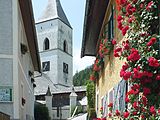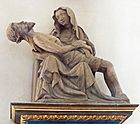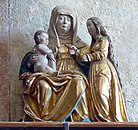Parish Church of Pürgg
The Pürgg parish church is located in the village of Pürgg in the Stainach-Pürgg municipality in the Liezen district in Styria . The patronage of St. Georg's subordinate Roman Catholic parish church belongs to the dean's office of Upper Ennstal - Styrian Salzkammergut in the Graz-Seckau diocese . The church, which has existed for almost 900 years, is a listed building ( list entry ).
location
The church and the surrounding cemetery and the neighboring rectory are at the end of a 150-meter-long cul-de-sac that branches off the main street of the village to the southwest, and thus also at the southwest end of the village. It is picturesquely located at 770 m above sea level on the edge of a high plateau above the Ennstal and opposite the eastern slope of the 2351 m high Grimming .
history
The church in Pürgg was consecrated on July 17, 1130 by the Seckau Bishop Wocho . It was a three-aisled Romanesque building with a tower over the choir square . This three-aisle structure still exists today. When the Gothicization began at the beginning of the 14th century , the tower above the choir was replaced by a mighty tower on the west side. The choir was also renewed in the Gothic style. Whose consecration took place in 1324. Under the choir was a charnel house built, which also was made possible in particular when the terrain from the tower falls down heavily to the choir. The round apses of the side aisles were retained. The arching of the formerly flat-roofed ships took place in the 15th century. The crypt hall of Count Lamberg was built on the west facade in 1904 on the former family crypt of Count Stainach.
Pürgg was founded as the prince's own church , who belonged to the Traungau family , the margraves of Styria. However, an independent parish soon emerged, which was very powerful in the High Middle Ages and reached from Aussee to Liezen . The pastors were at the same time landlords and often played a role that extended far beyond the parish, whereby they were then represented by vicars at home . The best known should have been Konrad Zeidler († 1442), who held the office of chancellor at the court of Friedrich III. clothed when this king was. He was also provost of St. Stephan in Vienna and pastor of the cathedral in Graz . His tombstone is in the south aisle.
Building description
The Georgskirche is a white plastered building with a shingle roof . The massive square tower on the west side is about the width of the central nave and has a pyramid roof . The central nave comprises three bays , which are divided by fluted pillars and of which the west is occupied by the organ gallery. The central nave is accompanied by two narrow aisles, the northern one being higher than the southern one and since the middle of the 15th century it has had a gallery .
The somewhat narrower choir adjoins the central nave. This has a 5/8 end with outer buttresses . Its three high lancet windows have original glazing from the second quarter of the 14th century (right), from 1877 and from 1914.
The door in the west portal of the church is Romanesque. She wears spirals made of wrought iron to ward off evil spirits. Another entrance to the church is a special feature of Pürgger. A wooden bridge closed on all sides leads from the rectory to the church at the level of the gallery above the north aisle with a brick supporting pillar halfway there.
From here you can also get to the Tower Lautkammer. In 1953 frescoes from around 1300 were uncovered. Scenes of the Passion of Christ and the life of St. Catherine are depicted in two circumferential stripes , which is why the room is also called St.
Furnishing
At the main altar is the Gothic cafeteria with tracery on the back made of red marble . The essay consisting of a tabernacle and a baldachin column was created in 1793/1794 by the Mitterndorfer artist Johann Fortschegger (1743–1827). He also designed the classicist pulpit with the theme of the sower . Opposite the pulpit hangs a large crucifix from the end of the 16th century. The high -quality figures of saints and martyrs on the pillars of the central nave date from the 18th century . It are John Nepomuk and Francis Xavier and Barbara and Katharina opposite.
In the south aisle, the altar in the small Romanesque apse is dedicated to Francis Xavier. In addition to other saint sculptures, a Pietà from 1425 made using the stone casting technique stands out. The figure group Anna selbdritt from around 1520 comes from the Upper Austrian carver Leonhart Astl . A Gothic baptismal font with a date of 1483 on the base has a carved top from the second half of the 17th century.
St. Alexius is venerated in the altar from 1697 in the north aisle . On the gallery of the north aisle there is a Chapel of Our Lady with an altar of Mary from the 17th century. On the gallery parapet, facing the nave, a portrait bust under a stone canopy depicts a young cleric , probably Konrad Zeidler. To the right and left, lions hold two coats of arms, the shield of the Babenbergs and the Styrian panther , which first appeared at the Traungauers.
organ
In 1793 the church received an organ . It had been built a few years earlier by Nikolaus Rummel the Elder (1708–1794) for the parish church in St. Peter in der Au (Lower Austria). Since it turned out to be too small for this church, the Steyr organ builder Peter Hötzel transferred it to Pürgg with the addition of six further registers . After several repairs and modifications, the current registration of the instrument after the general renovation in 1996 is:
|
|
|
|
|||||||||||||||||||||||||||||||||||||||||||||||||||||||||||||||||||||||||||||||||||||||||||||||||||||||||
literature
- Christine Rabensteiner, Helga Hensle-Wlasak: Parish Pürgg in the Ennstal . Kunstverlag Hofstetter Ried im Innkreis 1998
Web links
- Catholic parish church of St. George. In: Ennstal-Wiki. Retrieved September 15, 2015 .
- Parish church of St. Georg zu Pürgg. In: Parish Association of Stainach-Pürgg-Wörschach. Retrieved September 15, 2015 .
- Parish Church of Pürgg. In: Market town of Stainach-Pürgg. Retrieved September 15, 2015 .
- Pürgg. In: Heimatlexikon - Our Austria. Retrieved September 15, 2015 .
- Harald Matz: The Nikolaus Rummel organ in the parish church of St. Georg zu Pürgg . In: Website Orgelbau Walcker. Retrieved September 15, 2015 .
Individual evidence
- ^ RegiowikiAT: Konrad Zeidler
Coordinates: 47 ° 31 '49.1 " N , 14 ° 4' 1.1" E













